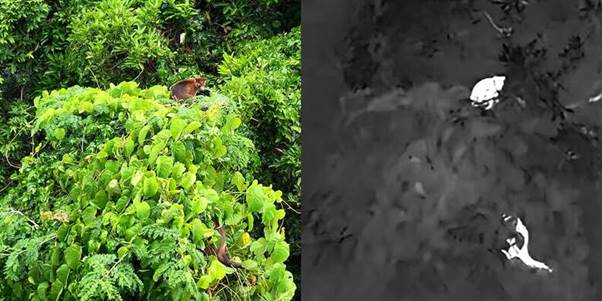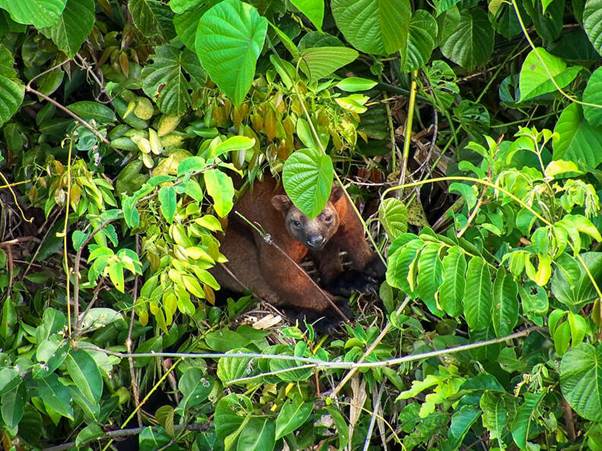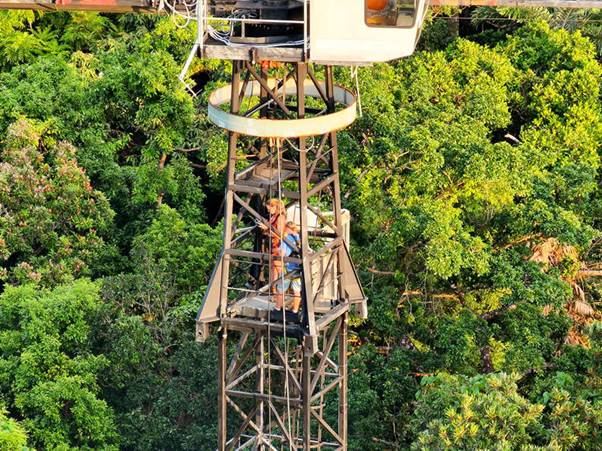Deep in the lush rainforests of northern Australia and New Guinea, far above the reach of human eyes, lives one of the most enigmatic marsupials in the world — the tree kangaroo. Unlike their well-known relatives that bound across Australia’s plains, tree kangaroos have adapted to an entirely different lifestyle. Their powerful forelimbs, broad paws, and unusually long tails allow them to climb high into the canopy, where they leap between branches with astonishing agility.
Despite these remarkable abilities, tree kangaroos are rarely seen. They are naturally elusive, camouflaged by dense leaves, and the places they inhabit are among the most rugged and inaccessible landscapes on the planet. For decades, researchers struggled to study them. Trekking through rainforests for days often resulted in only a fleeting glimpse — if that. In fact, biologists sometimes spent weeks without spotting a single individual.
Because of their scarcity and the challenge of observation, tree kangaroos acquired a reputation as “near-mythical creatures.” Their existence was acknowledged, yet their numbers, behaviors, and precise habitats remained largely unknown. As deforestation and climate change accelerated, concern for their future grew, but conservationists faced an uphill battle without reliable data. Protecting an animal you can barely find is no easy task.
This mystery, however, began to unravel when scientists decided to approach the problem from an entirely new angle — not by searching through the trees themselves, but by looking down from above.

Innovation From Above: How Drones Changed the Game
The turning point came when researchers introduced thermal drones into their fieldwork. Traditionally, conservation surveys relied on people walking through thick vegetation, climbing steep slopes, and using binoculars to scan the canopy. This method was exhausting, limited, and far from efficient. At best, researchers might confirm a few sightings in a week, and even then, the information gathered was minimal.
Thermal drones, however, provided a revolutionary solution. Outfitted with infrared cameras, these lightweight flying machines detect heat signatures. Every warm-blooded animal gives off body heat, which appears clearly on the drone’s screen, even through heavy foliage. For the first time, scientists could spot hidden creatures without disturbing them or cutting through dense undergrowth.
Emmeline Norris, a researcher leading the project, described the breakthrough: “Thermal drones may help to unravel the mysteries of tree kangaroos and guide long-term efforts to protect them.”
The team launched their drones over the Cape Tribulation region in Queensland, an area long suspected of harboring Bennett’s tree kangaroos. They conducted three separate flights, each lasting under an hour. What they found astonished them.
Instead of spotting one or two individuals, as they expected, the drones revealed six tree kangaroos in a single session. To researchers accustomed to scarcity, this was an unprecedented result. For Norris and her colleagues, it was a moment of validation — proof that their new approach could transform how these animals are studied.
Equally important, the drones allowed scientists to observe the kangaroos without stress or intrusion. Unlike ground surveys, which sometimes frightened the animals or altered their behavior, aerial monitoring kept interactions minimal. The kangaroos remained undisturbed in their natural routines, giving researchers a clearer window into their authentic lives.
This single success opened up a new realm of possibility. If drones could so easily locate tree kangaroos — perhaps the hardest marsupials to track — then similar methods might work for other elusive species. Conservation biology, long constrained by the limits of human endurance in the field, suddenly had a powerful new tool.

Why These Discoveries Matter
At first glance, finding six animals may not sound like much. But in the world of conservation, where sightings are scarce and populations uncertain, it was monumental. These results hinted that Bennett’s tree kangaroos might be more widespread in certain areas than previously believed.
Tree kangaroos are ecological indicators. Their health reflects the health of the rainforest canopy as a whole. By feeding on leaves and fruits, they help regulate vegetation and disperse seeds, supporting the delicate balance of plant life. If their populations decline, it could signal broader environmental instability.
Sadly, their survival has always been fragile. They rely heavily on continuous forest corridors to move between feeding and resting spots. When humans clear forests for logging, agriculture, or infrastructure, the canopy becomes fragmented. This forces tree kangaroos to descend to the ground, where they face threats from predators, dogs, vehicles, and hunters. Climate change adds further uncertainty, altering rainfall patterns and shifting vegetation zones.
The new drone findings bring cautious optimism. They suggest that, in some protected rainforests like Cape Tribulation, these animals may be holding on better than feared. But researchers are careful not to celebrate too soon. As Norris explained, “While this is encouraging, further systematic surveys are needed to assess how population density varies with forest type, elevation, and other factors.”
For conservationists, this technology offers more than numbers. It provides evidence that can shape policy. With reliable data, organizations can push for stronger protections, argue against deforestation in key habitats, and design wildlife corridors that ensure the canopy remains connected. It also allows conservation groups to monitor long-term population trends, spotting declines before they become irreversible.
Beyond science and policy, there is also something deeply human about these discoveries. For local communities and the broader public, stories of “mythical” animals revealed by new technology spark wonder. They remind us that even in a modern world dominated by cities and machines, there are still hidden corners of nature full of mystery waiting to be uncovered.

Looking Ahead: From Shadows to Security
The successful drone flights mark the beginning of a new era in wildlife conservation. Scientists now plan to expand their surveys, flying over different rainforest regions, elevations, and forest types to compare population densities. Combining drone work with other techniques — such as camera traps, sound recorders, and genetic analysis of droppings — could create a more complete picture of tree kangaroo life.
If these efforts succeed, they may not only save the tree kangaroo from obscurity but also set a precedent for studying other elusive creatures. From gliders and possums in Australia to primates in African jungles, the applications are nearly endless.


